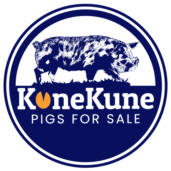For KuneKune breeders, Coefficient of Inbreeding (COI) is key to supporting the long-term health of this heritage pig breed.
In this article, we’ll start with the basics – What COI is and how it’s calculated. We’ll explore specific COI guidelines tailored to KuneKunes, look at the risks of High vs Low COI, and discuss ethical KuneKune breeding approaches like linebreeding.
My goal is to equip breeders with COI knowledge to make informed mating decisions that maintain genetic diversity. Properly managing COI enables us to improve our KuneKune herds while avoiding pitfalls like inbreeding depression. Let’s dive in to one of the most important topics, What is COI?

What is COI?
The Coefficient Of Inbreeding (COI) measures how genetically close two KuneKune pigs are to each other. It is the probability that a pig receives two identical copies of the same gene from an ancestor shared by its parents. A Higher COI percentage (%) indicates the parents are more genetically related.
COI was first described by geneticist Sewall Wright in 1922 to quantify inbreeding in populations. By studying family trees and ancestry, he created a mathematical formula to estimate genetic diversity.
Over the last century, COI has become an essential tool for KuneKune Breeders and scientists. Responsible breeding balances selection for desired traits with genetic health and diversity. Understanding COI helps us do that!
How is COI Calculated?
Coefficient of inbreeding (COI) is calculated by using a mathematical formula to analyze pedigree information. The formula used is:
F = (1/2) i-1 x (1+FCA)
- F represents the COI for the individual in question.
- i is the number of generations between two individuals.
- FCA is the coefficient of inbreeding of the common ancestor.

For example, if two siblings mate, their offspring’s COI would be calculated as:
F = (1/2)2-1 x (1+0)
Since the parents are separated by 1 generation (siblings), i equals 2. And since the parents do not have their own prior inbreeding, their FCA is 0.
Plugging this into the formula, we get:
F= (1/2)1 x (1+0) f = 0.25 or
25%
This means the offspring of two siblings would have a 25% COI, because there is a 25% chance of getting identical gene copies from each parent.
The higher the number of shared ancestors between parents, the higher the resulting COI. This formula quantifies ancestry to measure genetic diversity.
What are Alleles?
Alleles are variant forms of a gene. KuneKune pigs have many different genetic markers and alleles that impact traits such as:
- Production traits – Appetite, feed intake, growth rates, meat quality
- Reproduction – Litter size, fertility, and ovulation
- Appearance – Coat color, Piri Piri (tassels), coat type
- Disease resistance – Immune response, resistance to E. Coli
Monitoring alleles helps manage inbreeding and COI in KuneKunes. By tracking inheritance patterns, breeders can maintain genetic diversity and rare alleles.
Excessive inbreeding causes loss of alleles, which cannot be recovered. Low COI helps preserve allelic diversity for long-term breed health.
KuneKune breeders balance allele selection for desired traits with minimizing COI. This sustainable approach allows steady improvement while avoiding pitfalls of inbreeding depression.
Why is COI important when breeding KuneKune Pigs?
Monitoring COI is critical for KuneKune breeders to maintain healthy, diverse herds. COI over 10% is considered high risk, while under 5% would be considered ideal. A higher COI indicates more inbreeding between the parents. Here’s why those thresholds matter:
What is a High COI for KuneKune Pigs?
A COI above 10% puts KuneKune pigs at risk for:
- Smaller litter sizes and weaker piglets (Saura et al., 2015)
- More illness and genetic defects
- Fertility problems
- Shorter lifespans
This level of inbreeding leads to something called “inbreeding depression” – where the whole herd’s health declines due to a lack of genetic diversity. Minimizing high COI helps avoid these risks and maintain hardy KuneKune pigs.

What is considered a Low COI for KuneKune Pigs?
A COI below 5% should be a goal for most breeders. This threshold indicates substantial genetic diversity. While not always achievable it is something we strive for in our herd. Benefits include:
- Maintaining breed variety
- Avoiding inbreeding issues like infertility and illness
- Improved litter sizes and reproductive performance
- Enhanced disease resistance
- Adaptability to environmental changes
The 5% guideline is tailored specifically to preserve diversity in the small KuneKune breed. Having a lower COI supports overall health, welfare, and longevity in KuneKune herds over generations.
Ethical Breeding Practices and KuneKune Pigs
What is Linebreeding?
Linebreeding involves mating closely related individuals, such as parents to offspring or siblings. It aims to “lock in” desired traits by increasing homozygosity in a controlled way.
Some common linebreeding strategies used in swine breeds include:
- Breeding half-siblings (same father, different mothers)
- Father-daughter or mother-son pairings
- Aunt/uncle to niece/nephew matings
While linebreeding can rapidly set traits, it raises ethical concerns and poses health risks.
What are the Risks of Linebreeding?
- Ethical issues – Close inbreeding goes against animal welfare beliefs of many breeders and consumers. KuneKunes deserve consideration of their wellbeing.
- Health risks – Studies show linebreeding correlates with higher illness rates, physical defects, reduced fertility, and shorter lifespans in swine.
- Loss of diversity – Linebreeding can cause alleles to be lost through genetic drift. This irreversible loss of heterogeneity harms long-term breed health.
Conscientious KuneKune breeders weigh risks vs. benefits carefully and prioritize ethics and animal welfare above all else.
Solutions to Avoid High COI: Introducing New KuneKune Bloodlines!
One of the best strategies for developing a healthy COI within your herd is to look for new KuneKune Bloodlines that your herd has never been exposed too. Running the COI calculations prior to purchasing your new pigs can be a very effective way to project potentially healthy offspring of your presumed pairings. That being said you should always be looking to improve upon the qualities and expand on areas of weaknesses of your current breeding stock. As we have discussed within this article it is imperative for breeders, that are trying to improve the breed, document and asses their current breeding stock to find oppurtunities to improve their herd.
Key Takeaways for KuneKune Pig Breeders
For KuneKune pig breeders, closely monitoring COI is essential to supporting long-term health and welfare. Here are some key takeaways:
- COI indicates the degree of inbreeding. Higher COI means more homozygosity and reduced diversity.
- Maintaining low COI under 5% helps avoid weakened fitness from inbreeding depression.
- High COI over 10% raises risks of infertility, illness, and mortality based on swine studies.
- Strategic outcrossing optimizes COI, but pedigree tracking is crucial for planning low-COI pairings.
- Beyond COI, ethical practices prioritizing welfare are vital. Pigs deserve excellent care at all life stages.
- Balancing selection and diversity through COI management allows steady improvement without compromising sustainability.
By understanding the impacts of COI and alleles, KuneKune breeders can make informed mating decisions. This supports genetically thriving pigs for generations to come!




